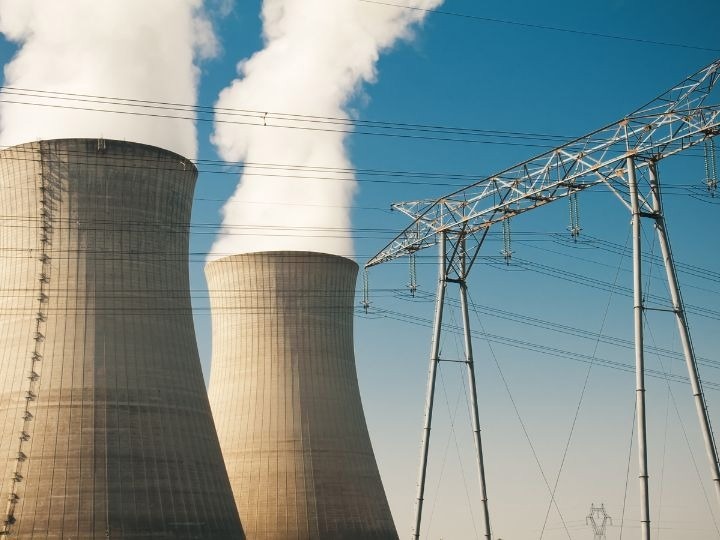Nuclear energy has resurfaced as a hot topic in a world deeply concerned about the environmental and geopolitical consequences of fossil fuel use. Its ability to generate electricity on a large scale while emitting no greenhouse gases holds promise as a long-term clean energy source that could bridge society’s transition away from fossil fuels and toward a net-zero future.
 A team of University of Houston researchers has discovered molecular crystals capable of capturing iodine—one of the most common radioactive fission products. The versatile crystals could be used for nuclear waste management and other energy-related applications. Image Credit: University of Houston
A team of University of Houston researchers has discovered molecular crystals capable of capturing iodine—one of the most common radioactive fission products. The versatile crystals could be used for nuclear waste management and other energy-related applications. Image Credit: University of Houston
Nuclear power generation, on the other hand, generates radioactive waste. The safe disposal of nuclear waste remains a critical challenge that must be addressed to gain public trust in this transformative power solution.
Scientists from the University of Houston have now developed molecular crystals based on cyclotetrabenzil hydrazones as a novel approach to managing nuclear waste. These crystals can capture iodine, one of the most prevalent radioactive fission products, in aqueous and organic solutions, as well as at the interface between the two. They are based on a ground-breaking discovery made by the group in 2015.
This last point is particularly salient because iodine capture on interfaces could prevent the iodine from reaching and damaging the specialized paint coatings used in nuclear reactors and waste containment vessels.
Ognjen Miljanic, Study Corresponding Author and Professor, Chemistry, University of Houston
The research was published in the journal Cell Reports Physical Science and was funded by the National Science Foundation.
These crystals have an incredible iodine uptake capacity, outpacing porous metal-organic frameworks (MOFs) and covalent organic frameworks (COFs), originally believed to be the pinnacle of iodine capture materials.
The discovery was made while Alexandra Robles, the study’s first author and a former doctoral candidate whose dissertation was based on this investigation, was working with the crystals in Miljanic’s lab. Robles looked into using crystals to capture iodine because she was interested in finding a way to deal with nuclear waste.
She ended up capturing iodine on the interface between the organic and water layers, which is an understudied phenomenon. When the material is deposited between the organic and aqueous layer, it essentially stops the transfer of iodine from one layer to another.
Ognjen Miljanic, Study Corresponding Author and Professor, Chemistry, University of Houston
This procedure not only maintains the integrity of reactor coatings and improves containment, but it also allows for transferring the captured iodine from one location to another. “The idea here is that you capture it at a place where it's difficult to manage, and then you release it at a place where it's easy to manage,” Miljanic notes.
Additionally, this catch-and-release technology allows for the reuse of the crystals. “If the pollutant just sticks to the regent, the whole thing has to be thrown away. And that increases waste and economic loss,” Miljanic adds.
These incredible potentials must be tested in real-world applications, which has Miljanic thinking about the next steps.
Molecules, Crystals and Octopi, Oh My!
Miljanic’s team uses commercially available chemicals to generate these tiny organic molecules made up of only carbon, hydrogen, and oxygen atoms.
The research team dubbed each crystal “The Octopus” because it is a ring-shaped structure with eight linear pieces emanating from it.
“They are quite easy to make and can be produced at a large scale from relatively inexpensive materials without any special protective atmosphere,” says Miljanic.
In an academic lab, he estimates that he can presently produce these crystals for about $1 per gram. Miljanic believes that the cost would be substantially lower in an industrial setting.
These voracious little crystals can capture more than just iodine. Miljanic and his colleagues have used some of them to capture CO2, which would be another significant step toward a cleaner, more sustainable world. Furthermore, the molecules in “The Octopus” are closely linked to those observed in materials used to make lithium-ion batteries, which paves the way to new energy opportunities.
This is a type of simple molecule that can do all sorts of different things depending on how we integrate it with the rest of any given system. So, we’re pursuing all those applications as well.
Ognjen Miljanic, Study Corresponding Author and Professor, Chemistry, University of Houston
The crystals’ immense potential excites him, and he is eager to investigate how they might be used in real life. Finding a partner who will assist the scientists in exploring various commercial aspects is his next objective.
To improve them until then, the researchers intend to dig deeper into the kinetics and behaviors of the crystal structures.
Journal Reference:
Robles, A., et al. (2023) Cyclobenzil hydrazones with high iodine capture capacities in solutions and on interfaces. Cell Reports Physical Science. doi.org/10.1016/j.xcrp.2023.101509.